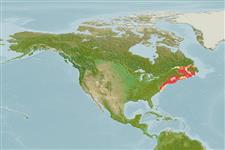ກຸ່ມປາກະດູກອ່ອນ (ເຊັ່ນ: ປາສະຫລາມ, ປາຜາໄລ) (sharks and rays) >
Rajiformes (Skates and rays) >
Rajidae (Skates)
Etymology: Leucoraja: Greek, leykos = white + Latin, raja = a fish, Raja sp. (Ref. 45335).
More on author: Mitchill.
Environment: milieu / climate zone / depth range / distribution range
ນິເວດວິທະຍາ
ສັດທະເລ ອາໄສຢູ່ໃກ້ໜ້າດິນໃຕ້ພື້ນທ້ອງນ້ຳ; ປາທີ່ມີການເຄື່ອນຍ້າຍໃນສະເພາະມາະຫາສະມຸດ (Ref. 51243); ລະດັບຄວາມເລິກ 4 - 723 m (Ref. 106604). Temperate; 51°N - 34°N, 79°W - 55°W (Ref. 55278)
Western Atlantic: Newfoundland Banks and southern Gulf of St. Lawrence in Canada to North Carolina, USA.
Length at first maturity / ຂະໜາດ / ນ້ຳໜັກ / Age
Maturity: Lm 74.5, range 73 - 76 cm
Max length : 113 cm TL ຕົວຜູ້/ບໍ່ມີເພດ; (Ref. 106604); ອາຍຸສູງສຸດທີ່ເຄຍລາຍງານມາ: 21 ປີ (Ref. 52109)
Short description
ຕົວທີ່ໃຊ້ໃນການຈຳແນກຊະນິດ | ສະລີລະວິທະຍາ | ການວັດແທກຮູບຮ່າງລັກສະນະພາຍນອກຂອງດິນ,ສັດ,ປາ…
Disk rounded, with many small dark spots on upper surface. Usually 1-4 ocelli on upper surface on each side of disk, each with a dark brownish center and pale edge. Young have long middorsal row of large spines on disk and tail. Upper jaw has 72 rows of teeth (Ref. 7251). Lower surface usually white but marked with irregular pale brownish blotches (Ref. 6902).
Prefer sandy and gravelly bottoms in shoal water in the north range; to at least 90 m in south (Ref. 7251). Benthic (Ref. 5951). Those caught at Cans, Nova Scotia in Canada were found to have eaten dollarfish, cunner, and squid. Mostly inactive during daylight hours, but active under dark conditions (Ref. 10807). Oviparous. Distinct pairing with embrace. Young may tend to follow large objects, such as their mother (Ref. 205). Eggs are oblong capsules with stiff pointed horns at the corners deposited in sandy or muddy flats (Ref. 205). Egg capsules are 5.5-9.9 cm long and 3.5-5.3 cm wide (Ref. 41249, 7135, 71301).
Electric organ discharge (EOD) activity seemed more frequent during dark periods (Ref. 10808). The individual EOD of this species is monophasic, head-negative, and lasts 217 ms (Ref. 10011). This species is used only for the manufacture of fish meal.
Life cycle and mating behavior
Maturities | ການສືບພັນ | Spawnings | Egg(s) | Fecundities | ຕົວອ່ອນ
Oviparous, paired eggs are laid. Embryos feed solely on yolk (Ref. 50449). Distinct pairing with embrace. Young may tend to follow large objects, such as their mother (Ref. 205).
McEachran, J.D. and K.A. Dunn, 1998. Phylogenetic analysis of skates, a morphologically conservative clade of elasmobranchs (Chondrichthyes: Rajidae). Copeia 1998(2):271-290. (Ref. 27314)
IUCN Red List Status (Ref. 130435)
Threat to humans
Harmless
Human uses
ເຄື່ອງມື
Special reports
Download XML
ແຫຼ່ງອີນເຕີເນັດ
Estimates based on models
Preferred temperature (Ref.
123201): 1.5 - 14.4, mean 7.9 °C (based on 130 cells).
Phylogenetic diversity index (Ref.
82804): PD
50 = 0.5000 [Uniqueness, from 0.5 = low to 2.0 = high].
Bayesian length-weight: a=0.00263 (0.00232 - 0.00298), b=3.23 (3.20 - 3.26), in cm total length, based on LWR estimates for this species (Ref.
93245).
ຊັ້ນເຂດຮ້ອນ (Ref.
69278): 4.4 ±0.5 se; based on diet studies.
ຄວາມຢືດຢຸ່ນ (Ref.
120179): ຕຳ່ຫຼາຍ, ປະຊາກອນຕຳ່ສຸດທີ່ໃຊ້ເວລາສອງເທົ່າຫຼາຍກວ່າ 14 ປີ (tmax=20.8; tm=11-12; Fec assumed to be <100).
Prior r = 0.04, 95% CL = 0.02 - 0.05, Based on 1 full stock assessment.
Fishing Vulnerability (Ref.
59153): High vulnerability (59 of 100).
Nutrients (Ref.
124155): Calcium = 10.8 [2.1, 52.6] mg/100g; Iron = 0.305 [0.081, 0.865] mg/100g; Protein = 17.6 [14.8, 20.3] %; Omega3 = 0.877 [0.282, 3.251] g/100g; Selenium = 10.7 [2.7, 33.9] μg/100g; VitaminA = 13.1 [4.1, 41.9] μg/100g; Zinc = 0.315 [0.151, 0.571] mg/100g (wet weight);
